Tools Needed:
- An air conditioning manifold gauge set
- A supply of R-134a refrigerant if needed for recharging (available locally)
- Open ended wrench set
An air conditioning manifold gauge set is a must-have tool for anyone who is interested in performing some basic system work at home, such as checking pressure in a/c lines, determining if there's a leak, adding small amounts of refrigerant, or performing a complete evacuation and recharge. Compact, hand-held manifold gauge sets are used universally when servicing home air conditioning systems as well as automotive ones, and professional technicians use them same way you can in your back yard. Although shops typically have large, costly machines that do the evacuating and recharging work, similar results can be achieved with equipment that can be purchased inexpensively and stored easily.

Because air conditioning hoses and o-rings are made of rubber, it is common for some of the a/c refrigerant to work its way out of the system over a period of several years. An a/c manifold gauge will allow you to give your system a recharge each year – keeping your vehicle cool while saving you a great deal of money over the vehicle's lifetime. A manifold gauge set will also let you determine if your system is fully charged or not, or if your system is losing pressure at a rate that indicates there is a large leak. Even if you won't be servicing the system yourself, it will help you determine whether you need repairs or just a recharge.
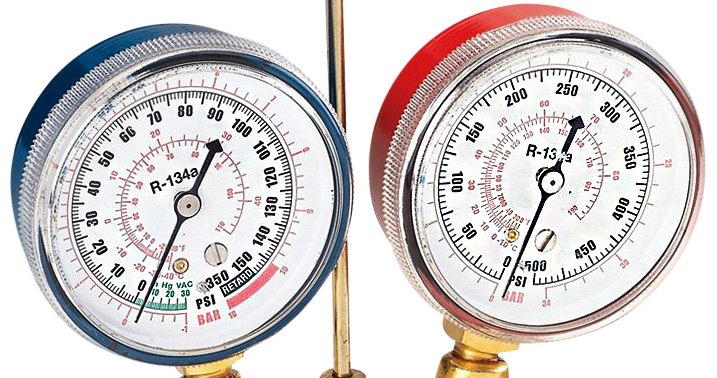
One of the important basics to know before using an a/c manifold gauge set is the type of refrigerant that your vehicle has. For reference, refrigerant type R-12 (also known as automotive refrigerant) was used from the earliest days of automotive a/c systems until the U.S. government outlawed it after the 1993 model year because of its harmful effect on the Earth's ozone layer. While some vehicles made a switch to newer R-134a refrigerant before they were required to, any 1994 model year vehicle sold in the United States was designed to operate on R-134a.
A sticker mounted in the engine compartment or on the underside of the hood will provide the refrigerant type, but if it's missing you'll also find the information in the owner's manual or by calling the vehicle manufacturer. If an older vehicle has been converted to R-134a, a new sticker stating so should be affixed in place of the original one. R-12 and R-134a use different size fittings in order to avoid mixing the two types of refrigerant.
Because R-12 is no longer manufactured and has not been used in cars for over 20 years, this article will focus on systems designed for R-134a. Universal manifold sets with fittings for both refrigerants are available, should you have an older vehicle or be unable to determine what kind of refrigerant is in your car or truck.
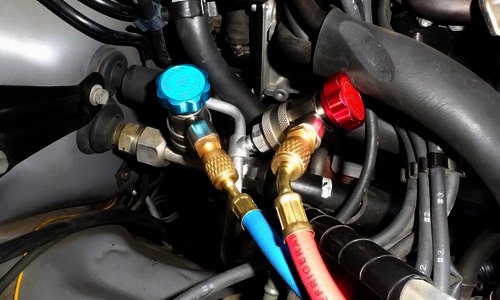
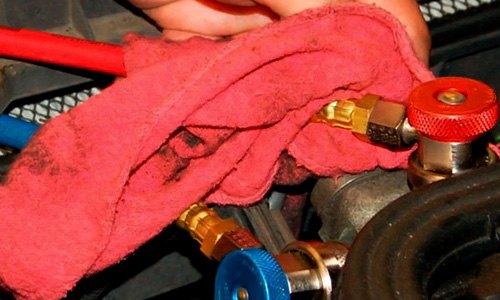
Looking at any a/c manifold gauge, you'll see a blue-colored pressure dial and hose on the left side, a red-colored pressure dial and hose on the right, and a yellow hose in the middle with no corresponding dial. Blue represents the low pressure side of the air conditioning system, and red represents the high pressure side. The low-side gauge is also known as a compound gauge because it can also provide a reading for vacuum (expressed in "inches of mercury") when performing an evacuation. The yellow hose in the center is designed for refilling the a/c system with canned refrigerant during recharging, and it can also be used for evacuating the system with a vacuum pump.
Hoses on a/c manifold sets easily connect and disconnect to fittings on the vehicle with Schrader style valve couplings. Some hoses are designed with "manual" couplers that feature a quick release button on top which must be depressed manually to lock the connection in place, and other hoses are designed with "automatic" couplers which click into place with a simple push. Instead of using a pushbutton to release, a lock ring is moved by hand. Whichever style is used, it is important that the blue hose is connected to the vehicle's low pressure side, and the red hose is connected to the vehicle's high pressure side.
Testing The Performance Of Your A/C
As a recommended first step, a quick pressure test of your vehicle's a/c system with it running will give you an idea if operating pressures are within specifications. After closing both low- and high-side valves on the manifold gauge set, connect hoses to respective low- and high-side pressure fittings on the vehicle. Start your engine and run the a/c system with all controls at their maximum setting until it has had time to cool the inside of the car. (Make sure that your car or truck does not overheat. In some situations, you may need to put a fan in front of the radiator to deliver additional airflow.) Open the valves on the manifold set, then check low and high pressures on the dials, comparing the readings to the normal range of the operating pressures specified in your owner's manual or repair guide.
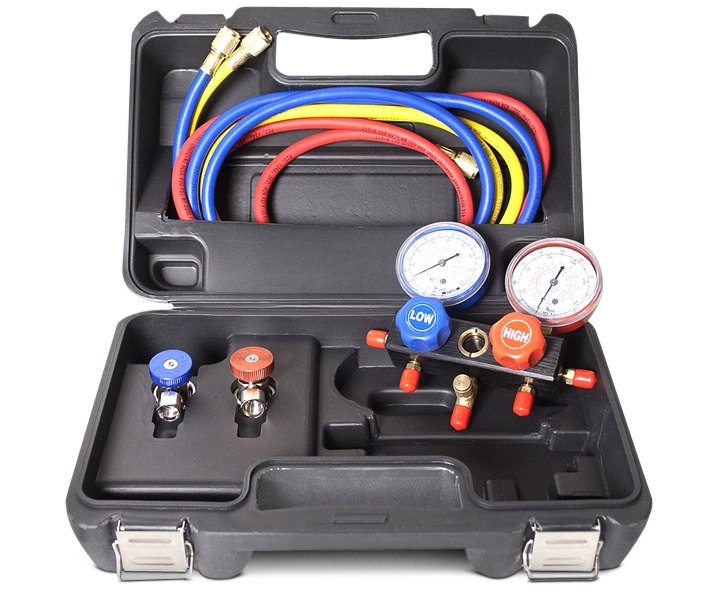
Excess high-side pressure can result from too much refrigerant in the system, a system restriction, air in the lines, or not enough airflow across the condenser (in front of the radiator). A too-low high-side pressure can mean refrigerant level is low or the compressor is malfunctioning. If the low-side pressure is higher than normal, suspect refrigerant overcharge or a defective compressor. Lower low-side pressure can mean there is a restriction in the low-side of the system, the refrigerant level is low, or there is not enough airflow across the condenser.
Topping Up Your A/C System
If you have found that your a/c system gradually lost cooling ability over time, and a pressure check shows both low side and high side pressures to be slightly low, you many only need to add a small amount of refrigerant. Service-sized cans of R-134a are available at most auto parts stores and even some hardware stores. If there is a small leak, you might be able to do an annual recharge, and you'll continue to enjoy cold air coming out of your vents provided there are no major leaks.
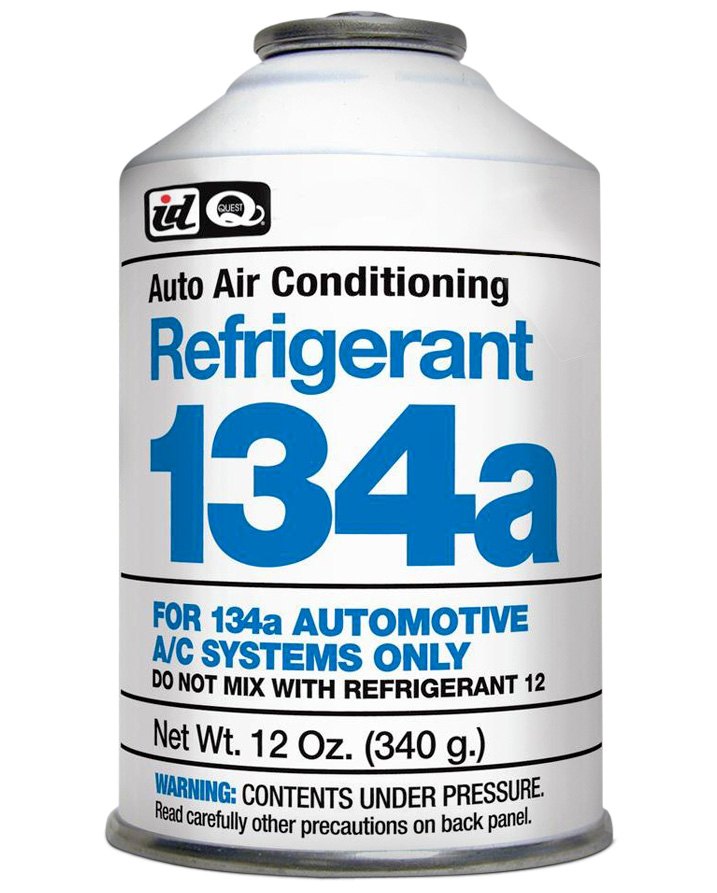
To recharge your a/c system, insert a valve in the can of new refrigerant you'll be using (you may need a wrench for this process depending on the valve design). Make sure the can and the valve knob are facing up to ensure you'll be drawing refrigerant vapor from the top of the can instead of liquid refrigerant from the bottom. The valve knob should also be in the closed position before installing it on the refrigerant container.
With the valve knob closed on the refrigerant canister, connect the yellow hose from the a/c manifold gauge set. With the line connected, open the valve on the can. The next step in the procedure is to bleed air out of the yellow line so that it does not get pushed into the a/c system. Do this by loosening (but not disconnecting) the yellow hose fitting at the top of the manifold gauge set until you hear air hiss out for two seconds.
With both low- and high-side valves still closed, start the vehicle and turn on the a/c to max. Open only the low side valve on the manifold.
Caution! Opening the high side valve when the a/c compressor is running will damage the compressor.
Watch the gauges, adding refrigerant only until the vehicle manufacturer's specifications have been reached. To stop adding refrigerant, close the manifold low-side valve. Turn the valve on the canister off.
Performing A Complete Evacuation And Recharge Of The A/C System
If your system is very low (or empty) on refrigerant, you should first diagnose and repair any large leaks in the system. Even if you do not have a leak, some professionals prefer a complete "evac & recharge" as the most accurate way of installing the exact amount of refrigerant required. Should you go this route, you'll need a compact electrical vacuum pump designed for automotive a/c systems. The process begins by twisting both low- and high-side valves on the manifold gauge set to the closed position (both on the gauge housing and at the hose ends), then connecting the hoses to respective low- and high-side pressure fittings on your vehicle. Once hoses are connected to vehicle fittings, open the valves where they attach to the vehicle.

Only the low-pressure side gauge has a reading for vacuum. When the system is being evacuated, the needle will travel to the other side of zero to reflect negative pressure (vacuum) in the lines as shown here. If the system holds vacuum pressure without dropping for 30 minutes after being evacuated, there are no leaks in the system.
Next, connect the yellow hose to your vacuum pump and turn it on. Once it's running, open the low and high-side valves on the manifold gauge housing. Let the pump run for 30 to 60 minutes until you see the low-side dial displaying a vacuum reading of 30 inches of mercury. The high-side gauge needle will remain at zero the entire time. Once proper vacuum has been reached, close both high and low-side valves and shut the pump off.
Now, watch the low side gauge for another 30 minutes. If vacuum holds for 30 minutes after the pump is shut off, the system does not have any leaks.
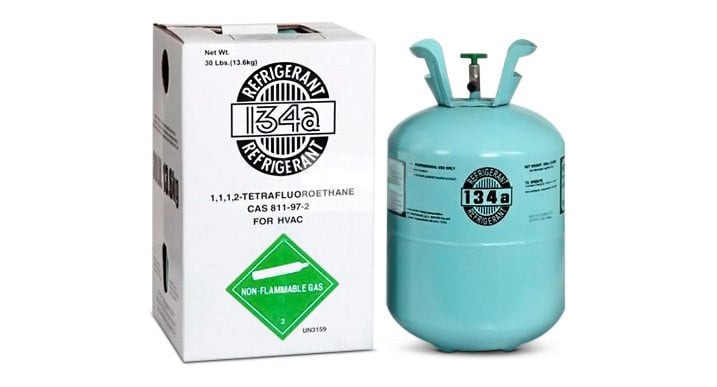
A decline in pressure means there's a large leak somewhere or water in the system has boiled off. To determine which is the case, repeat the evacuation process for 30 minutes with the pump, then let it sit again for another 30 minutes. If the pressure declines again, there is still a leak in the system which needs repair.
At this point, the recharge is similar to the above, except you want to have on hand the exact amount of refrigerant specified by your vehicle's manufacturer. Typically that spec is given in pounds, although you may find it in grams on imported vehicles. If you are using, let's say, a 30-lb. can of R134a, there are scales which will give you the 'before' and 'after' weight, so that you know you've added the correct amount. Once you've added the full charge, check the pressures one more time to ensure that are where they should be. (The manifold gauge sets from CARiD come complete with specific user's instructions.)
If you find that your ride's a/c system has a major leak and you are now in need of replacement components, CARiD has high-quality replacement parts as well as a/c hoses & o-rings, expansion valves, relays & switches, and other parts to keep your vehicle at OEM specifications and ensure things stay cool.

